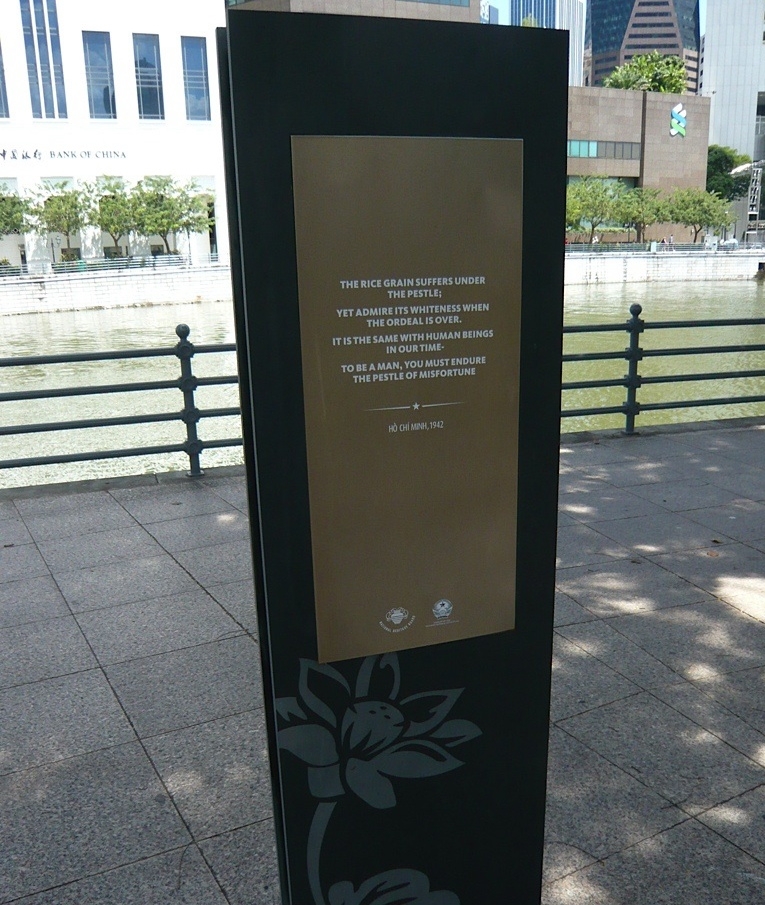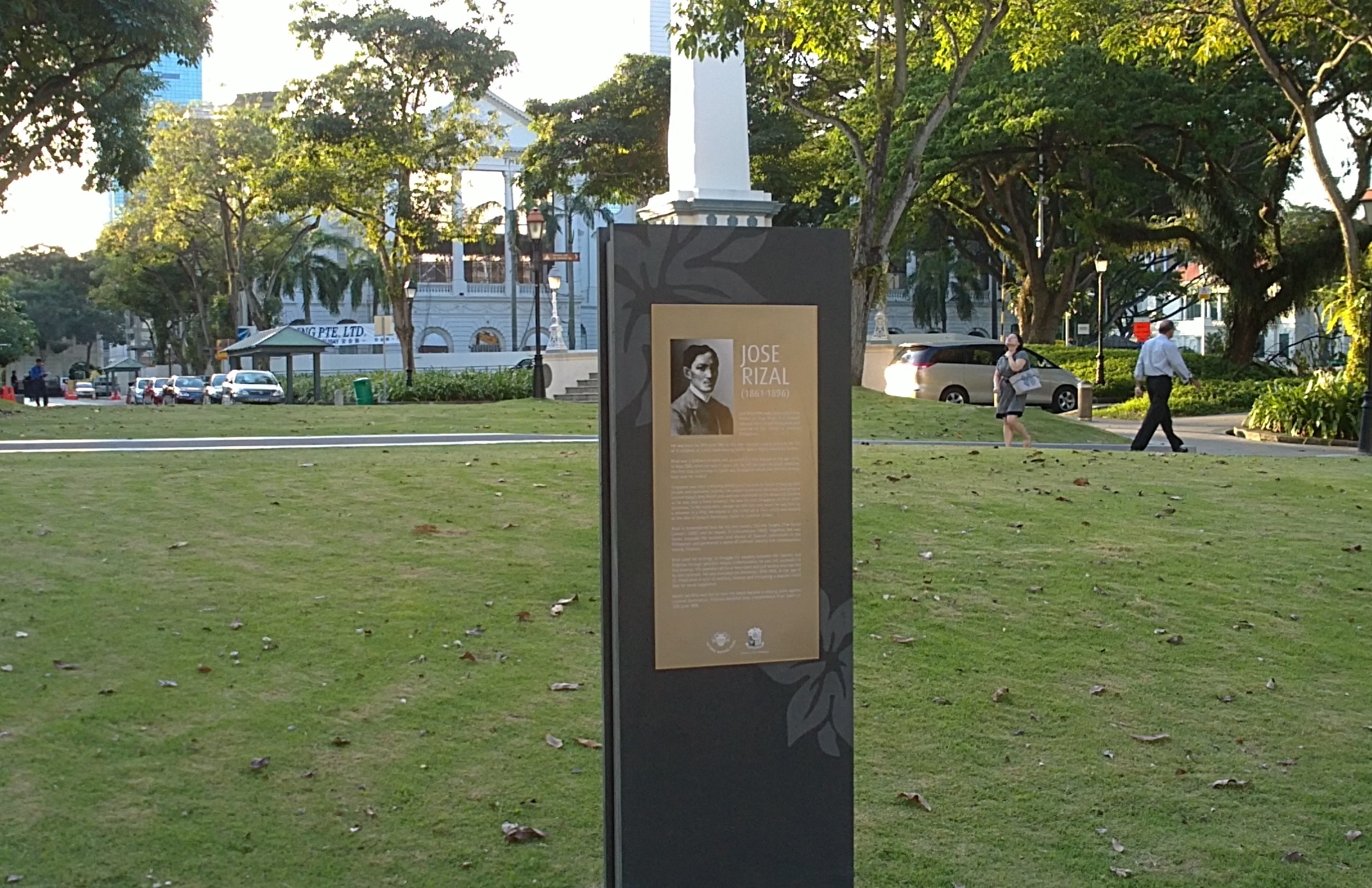The Lion City has chosen to honor Ho Chi Minh - the Father of modern Viet Nam, along with other liberators of China and Southeast Asia. These great men spent time in Singapore during their revolutionary years.
 |
| Pillar honoring Ho Chi Minh, Empress Place |
Sun Yat-sen (1866-1925) was a medical doctor and a political leader. He visited Singapore the first time in 1900 to raise funds for his revolutionary activities. He was arrested and banned from entering Singapore for five years. From 1905 he returned to Singapore regularly. Sun was playing a key role in the overthrow of the last imperial dynasty of China. He made Singapore his main base for gaining the support of overseas Chinese in Southeast Asia. He would stay at a hidden villa in Balestier, a few miles north of the city centre.
Back in 1880, a wealthy Chinese merchant had built the Balestier villa for his favorite mistress. In the early 1900’s, whenever Sun Yat-sen visited Singapore, he and his followers were given permission to use the premises. In 1911, a group of six leading Chinese businessmen, led by philanthropist Lee Kong Chian bought the villa and turned it into a historical site. During the Second World War, Japanese invading troops took over the villa and made it their communication headquarters.
Sixty years ago, the Chinese Chamber of Commerce in Singapore renovated the building and it became the ‘Sun Yat-sen Nanyang Memorial Hall’, housing a collection of more than 50 paintings and sculptures.
 |
| Back pillar with Ho Chi Minh’s poem |
The centre of Singapore’s civic life has always been a cluster of buildings including the Parliament House, the law courts and the old administration buildings, now housing the Museum of Asian Civilizations. The Singapore River runs alongside and on the other side of that narrow river are the towering skyscrapers of the business district – one of the world’s most powerful.
Walking along that riverfront, known as Empress Place, visitors would see a series of pillars. One of which honors Jose Rizal (1861-1896), overlooking the Cavenagh Bridge. Educated in France, Spain and Germany, Rizal had lived and traveled extensively in Europe and Asia. His political activities brought him to Singapore five times, on the last visit as a prisoner on a ship. Rizal became a prominent figure of political and social reform movements during the Spanish colonial era. His prolific political writings and his appeals to the public triggered the Philippines Revolution in August 1896. Rizal was executed by a firing squad of the Spanish Army in December that year. He was 35 years old.
The Philippines Revolution led to the Treaty of Paris in December 1898. This treaty essentially put an end to the Spanish Empire and marked the beginning of the colonial role of the United States. The agreement specified that Spain would cede to the United States the archipelago known as the Philippine Islands, and all the islands lying within a specified line. The treaty also assured that Spain would cede to the United States the island of Puerto Rico, other islands under Spanish sovereignty in the West Indies, and the island of Guam.
 |
| Sun Yat-sen’s Memorial in Balestier |
The United States’ aggression towards other countries was condemned by some senior American politicians, notably Senator George Frisbie Hoar, “The Treaty will make us a vulgar, commonplace empire, controlling subject races and vassal states, in which one class must forever rule and other classes must forever obey.”
Revered as a national hero, the anniversary of Jose Rizal’s death has been designated a public holiday in the Philippines, named ‘Rizal Day’.
Continuing along the waterfront, the next pillar is dedicated to Ho Chi Minh (1890-1969). Ho was an admirer of Sun Yat-sen and his political philosophy - nationalism, democracy, and the people\'s livelihood. Sun understood peoples’ lives under a colonial regime very well, and he was a keen supporter of Ho’s determination to liberate Viet Nam from the French. Before his death in 1925, Sun had asked his loyal followers to provide Ho with personnel resources and to help promote his political training institute in Canton, Guangzhou (1924 -27).
Ho Chi Minh visited Singapore the first time in May 1930, traveling from Bangkok, on his way to Hong Kong to meet members of his newly established Vietnamese Communist Party (Dang Cong San Viet Nam). He was arrested by the British police in Hong Kong and incarcerated at Victoria Prison. Facing a French death sentence and repatriation to Viet Nam, Ho received the help of Francis Loseby, a prominent English lawyer, now in Hong Kong, who had defended Sun Yat-sen years earlier in London. Loseby had saved the life of Sun Yat-sen. And he would save the life of Ho Chi Minh.
 |
| Pillar honoring Jose Rizal, Empress Place |
In January 1933, Ho was released from prison and left for Singapore. He was again arrested in Singapore by the British police and sent back to prison in Hong Kong. He was released again and left Hong Kong for China with the secret assistance of Francis Loseby, and the even more secret help of the wife of the colonial Governor.
In 1939, Ho returned to Singapore in disguise to gather support for future armed uprisings against the French regime in Indochina. Ho was living in China from 1938 to 1941, serving in the People’s Liberation Army and having a strong connection with the Chinese Communist Party (CCP). In August 1942, Ho suffered a stroke of ill fortune. He was captured by the Chinese Nationalists and endured 400 days of detention in Chiang Kai-shek’s prison system, in Guangxi. He was released in March 1944 and eventually was reunited with his compatriots in Pac Bo, near the Sino-Vietnamese border. In 1949, when Ho’s own forces were organized and mobilized, he began receiving generous financial and military assistance from the People’s Republic of China. In May 1954, Viet Nam defeated the French at the great battle of Dien Bien Phu, bringing an end to France’s colonial ambitions in Indochina, Africa, and elsewhere.
Ho Chi Minh’s pillar is overlooking the magnificent view of the Singapore River. Behind the pillar is the beautiful nineteenth century building of the Asian Civilizations Museum. Alongside the museum building, on the riverside, is the IndoChine restaurant, offering a lovely ambience to its diners. Throughout his life, Ho himself always adored the beauty of nature. He loved the outdoors and preferred a life of simplicity. This peaceful surrounding is a perfect choice for such tribute.
A political leader and statesman of more recent times, Deng Xiaoping, has been added to Singapore’s roll of honor. Deng’s greatest contribution to modern China was his remarkable economic reforms, gearing the country towards a market economy. China has become a prosperous nation, more than at any other time in its history. He is quoted on the pillar, saying that what matters more than anything else is ‘development’.

Leave your comment on this story